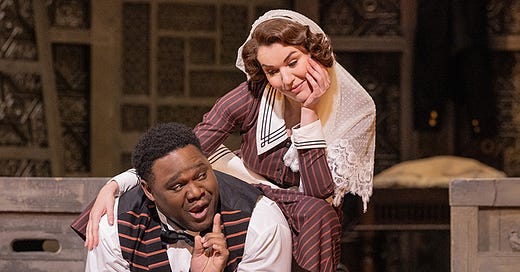A Magical 'Figaro' At the Met
The cast and conductor love Mozart, and it shows in their work
If you did not catch the live transmission of the Metropolitan Opera’s ‘The Marriage of Figaro’ on Saturday, all is not lost. You can enjoy an encore performance on Wednesday at a number of local theaters. Click here and click “Find Your Theater” for details.
I recommend it. I wrote about the experience of going to see the Metropolitan Opera in theaters, and while some variables are unpredictable, the quality of the performance was wonderful.
To be honest, I kind of made a face at first at the idea of shifting the action from the 18th century to the 1930s. I wasn’t sure, and I’m still not sure, why it’s necessary. Maybe the costumes are easier to get, and less expensive. However the production is beautiful to look at. I mean exquisite. I loved the color palette — the violets and red violets and deep rich purples.
And I will put this out there: Maybe the 20th century setting made the point that things had not changed that much in the last few hundred years. ‘Tis true. I always remember this wonderful Italian priest I knew who would say in his sermon: “There is nothing new under the sun.” That comes from Ecclesiastes.
The singers in the production (cast info here) are all excellent actors — vital when the production is being beamed out into theaters and audiences get merciless closeups of the action. Conductor Joana Mallwitz, making her Met debut, kept everything going at a brisk pace, while also slowing down wonderfully for the Countess’ two arias. I love the character of the Countess. I think Mozart really felt something for her.
Joshua Hopkins brought the right suave energy to the part of the Count. The Count and the Countess Almaviva are characters I love. Rossini’s “The Barber of Seville” tells the story of their courtship. By the time the Mozart opera takes place, they have been married several years, and they are growing apart — a sad story the Countess tells in her arias. Federica Lombardi sang those arias exquisitely. The world seemed to come to a halt.
Bass-baritone Michael Sumuel brought a fine-tuned sense of humor to Figaro. Listening to this opera, you can tell what inspired many of Rossini’s shenanigans surrounding the story. Mozart had fun with that “patter aria” concept. Sumuel had fun with it too. Olga Kulchynska was the perfect partner for him — never losing her cool. These two were great together. They should get married in real life, I found myself thinking.
I am fussy with singers playing Cherubino and I thought Sun-Ly Pierce hit it out of the park. Her boyish mannerisms were a kick. It always cracks me up when we get to that point when we have a girl dressed as a boy dressed as a girl. That has to be a challenge for anyone playing that part!
At intermission, the theater audiences get to watch interviews with the principals. The conductor and the cast members all seemed to have genuine feelings for Mozart and for this opera, as I do. It showed in their work.
Alas, because of technical difficulties, I did not get to see the concluding garden scene. That scene is pure magic. I remember writing in The Buffalo News once that it is as if Mozart shoots these melodies off one after another like a fireworks display — each more beautiful than the last.
Maybe I am not supposed to see it too often. In any case, I am sure the cast pulled it off beautifully.
Going to see the Met at the theater is an adventure! Read my account of it here.
Join me here in listening to the overture of this magical opera.
Find a theater here on the Met’s site if you would like to catch this opera in theaters. There shouldn’t be any technical difficulties this time.





